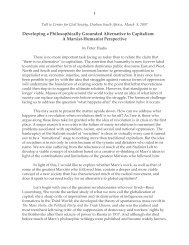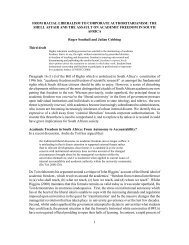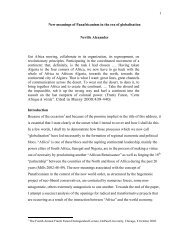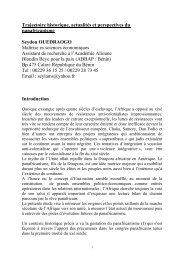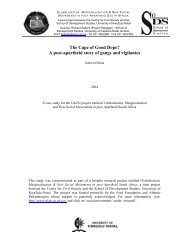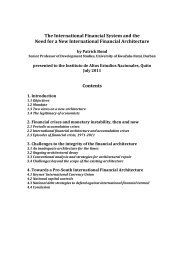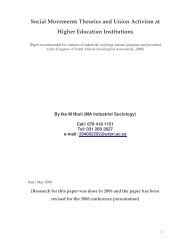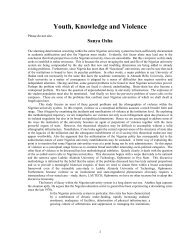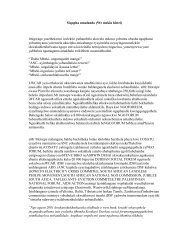April 2011 - Centre for Civil Society - University of KwaZulu-Natal
April 2011 - Centre for Civil Society - University of KwaZulu-Natal
April 2011 - Centre for Civil Society - University of KwaZulu-Natal
Create successful ePaper yourself
Turn your PDF publications into a flip-book with our unique Google optimized e-Paper software.
While cholera epidemics are caused by multiple factors, <strong>of</strong> which<br />
environmental influences are just one, Colwell and other experts are<br />
closely monitoring the potential impact <strong>of</strong> global warming on the diarrheal<br />
disease. “Although there is no clear understanding <strong>of</strong> the exact nature <strong>of</strong><br />
the relationship between cholera and climate,” says Tufts <strong>University</strong><br />
cholera expert Shafiqul Islam, “if climate change leads to more extremes,<br />
it will have an impact on cholera.” In fact, it may already have. Over the<br />
past 30 years, El Nino events in the Bay <strong>of</strong> Bengal — characterized, in part,<br />
by warmer sea surface temperatures — have increased, paralleling a rise in<br />
cholera cases in Bangladesh. The World Health Organization calls it “one <strong>of</strong><br />
the first pieces <strong>of</strong> evidence that warming trends are affecting human<br />
infectious diseases.”<br />
The growing understanding <strong>of</strong> the role that climate plays in cholera<br />
outbreaks has sparked disagreement between environmental scientists,<br />
such as Colwell, and the medical community. While many cholera<br />
researchers concur that these environment influences play an important<br />
role in the incidence <strong>of</strong> cholera, especially in places such as Bangladesh<br />
and India, most hail from medical fields, which continue to emphasize the<br />
role <strong>of</strong> human activity in the spread <strong>of</strong> the disease. Scientists such as<br />
Matthew Waldor, an infectious disease expert from Harvard <strong>University</strong>,<br />
worry that characterizing cholera outbreaks as a result <strong>of</strong> environmental<br />
influences undermines ef<strong>for</strong>ts to prevent the disease using vaccines and<br />
other methods.<br />
“There is an inevitability to the environmentalist arguments about<br />
cholera,” he says. “If cholera travels by the environment... then it is not<br />
preventable.” Whereas linking cholera outbreaks to human activity, he<br />
says, rein<strong>for</strong>ces the indisputable — and uncontested — truth that<br />
preventing cholera requires changing human activity.<br />
And yet, new research on cholera’s links to the environment may help<br />
minimize cholera’s damage in other ways. The macro-environmental<br />
factors that drive cholera can be tracked using remote sensing data and<br />
other <strong>for</strong>ecasting methods, opening up the possibility <strong>of</strong> an early warning<br />
system <strong>for</strong> cholera. Islam is among several scientists developing methods<br />
to use remote sensing data to track the coastal plankton blooms that<br />
presage cholera outbreaks. Satellite data on chlorophyll concentrations, a<br />
discernible proxy <strong>for</strong> zooplankton levels, can successfully predict cholera<br />
incidence, too. NOAA recently funded the development <strong>of</strong> a system to<br />
predict levels <strong>of</strong> Vibrio cholerae in the Chesapeake Bay using data on the<br />
bay’s changing salinity and surface temperature.<br />
In fact, cholera surveillance teams from the World Health Organization<br />
(WHO) have already used El Nino <strong>for</strong>ecasting to help prepare communities<br />
<strong>for</strong> potential cholera outbreaks, including one in Mozambique in 1997,<br />
predicted by the WHO based on <strong>for</strong>ecasts <strong>of</strong> El Nino-related drought in<br />
southeast Africa.<br />
What is clear is that populations <strong>of</strong> Vibrio cholerae in coastal waters,<br />
estuaries, and bays rise and fall in association with a range <strong>of</strong><br />
environmental factors. In Peru, levels <strong>of</strong> cholera vibrio bacteria have been<br />
linked to the temperature <strong>of</strong> local rivers; in Italy, to the surface<br />
temperatures <strong>of</strong> estuaries along the Adriatic coast. In Mexico, the<br />
abundance <strong>of</strong> cholera vibrios in lagoon oysters rise as seas warm. In the<br />
Chesapeake Bay, Vibrio cholerae levels increase during the summer, as<br />
water temperatures spike. In Bangladesh, cholera risk increases by two to<br />
four times in the six weeks following a 5-degree C (9-degree F) spike in the<br />
water temperature. Likewise, in Ghana, an analysis <strong>of</strong> 20 years <strong>of</strong> data



